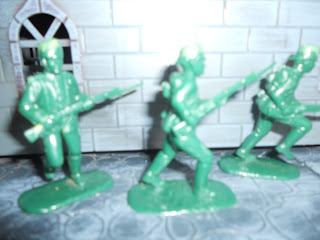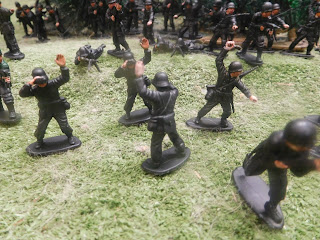The Legacy Of Frank Perry, Ross Perry And Ken Gillings. Part 1 Ross's PW Article.
My background in wargaming did not come via playing elaborate games with small scale figures. It came from my simple childhood games with 1/32 toy soldiers, most of them plastic.
As a teenager my mate Pete announced that 'propper' wargames were done with 20mm Airfix figures and so we stopped playing with 54mm and began assembling 20 mm armies for the ACW. I must admit I was excited by the Airfix catalogue with its painted examples of HO figures but I noted that Airfix also made 1/32 figures and I never entirely abandoned that scale, although for a while I just painted them.
A few things kept me interested in 1/32 wargaming. There were still wargaming books around that used the bigger scale. I acquired a number of books on toy soldiers and wargaming. Among those books were 'The First Book Of Wargaming' and 'The Second Book of Wargaming' by banker, Frank Perry. I bought these in the late 70s. I imagined people working in banking as being a bit dull but I wouldn't say that about Frank Perry. He obviously had a very fertile imagination and a great sense of fun.
The other contributions to my re-discovering 54mm wargaming were firstly joining ACOTS, the Australian Collectors of Toy Soldiers, a number of them being keen wargamers in 1/32 scale. The other was subscribing to and reading plastic Warrior magazine. Some early articles in PW were especially inspiring.
In issue 2 Frank's son, Ross Perry wrote the article, 'The origins of Our Hobby'. He writes of his father and fathers wargaming friend, Ken. Here is slightly condensed version:
'My vaguest memories are of my father, and his life long friend, Ken, meeting Sundays, every fortnight, to play with Britains lead soldiers on the dining room table'. The rules stemmed from HG Wells Little Wars. Eventually the soldiers migrated to a special wargaming loft. In fact that was generally the place Frank could be found.
'He and Ken, as small boys, created imaginary games as all boys do. in their case whole continents, such as Selucia and Caspia resulted. The two boys gradually decided to make the game more exciting by introducing two toy soldiers to represent themselves. the rest is history, from two models, armies, legions tribes and a whole new world was born.'
Now in my childhood games I certainly invented battle scenarios, including one where the British royal family and Royal guards were ambushed by German soldiers in WW2! but I didn't do anything as fabulous as use invented countries in my games (although I did invent them in my English school work).
Ross goes on to say: 'I must have been about eleven when I arrived on the scene. I was an incurable nuisance at the time, playing and breaking now precious modes (horror!), but extreme consideration and patience was exercised by the older players into introducing another smaller boy into the delights of larger scale wargaming. After all weren't they once small boys too?' (I hope other collectors and wargamers had the same wisdom).
'When Dad retired in 1973, he built his 30 foot shed ( better known as the wargame centre), where hundreds of a series of enjoyable games were played, the culmination being two unforgettable adventures named "The Caspros Experiment" and 'Mission to kill".
It's so simple to create your own countries and armies if you choose to do so. Not only do you release yourself of the drudgery of following historical games, over a period of time you create your own past, present and future. like anything else, model figures are just as precious as Stamps, Coins, Metal toys and other collectable items.'
Ross goes on to say he continued to play wargames with Ken and others and then reflects on modern Dungeons and Dragons games.
'I am surprised by two factors':
A. the cost of buying continued modules.
B. Set down rules must surely limit and discipline the order of play.
I have recently played a D&D game...where by using a minimum of rules but a maximum of imagination a great evening was had by all. 54mm figures were used on the 18 foot table in the wargame centre. I simply laid old house bricks down the table laid various traps and then put cloth over the entire scene. it was withdrawn slowly as my opponent advanced.'
Of Ken Ross says,, 'He was playing D&D style games in the 1920s, long before the modern counterparts.'
The concealed trap game reminds me of a game once set up by Bob Bolton with various factions from knights to Chinese Boxers trying to gain hidden treasure only to run into hidden skeleton warriors.
It wasn't until my adult years that I began having games with imaginary countries. These included a 'Lost land' of a tropical and supernatural nature with temples and all manner of creatures that Viking bands had to survive in order to escape with treasure. I set that one up for my young daughter.
My wargaming friend Mat and I played a campaign for some years between his Bogavania and my Beerstein. We are going to resume it later in the year with Mat leading Fezia with the remains of Bogavania as allies, this time at a more Renissance rather than medieval level of technology. I have to say that these PW articles were a big influence.
In future posts I'll be summarizing and commenting on some more PW articles and also Frank's books.
As a teenager my mate Pete announced that 'propper' wargames were done with 20mm Airfix figures and so we stopped playing with 54mm and began assembling 20 mm armies for the ACW. I must admit I was excited by the Airfix catalogue with its painted examples of HO figures but I noted that Airfix also made 1/32 figures and I never entirely abandoned that scale, although for a while I just painted them.
A few things kept me interested in 1/32 wargaming. There were still wargaming books around that used the bigger scale. I acquired a number of books on toy soldiers and wargaming. Among those books were 'The First Book Of Wargaming' and 'The Second Book of Wargaming' by banker, Frank Perry. I bought these in the late 70s. I imagined people working in banking as being a bit dull but I wouldn't say that about Frank Perry. He obviously had a very fertile imagination and a great sense of fun.
The other contributions to my re-discovering 54mm wargaming were firstly joining ACOTS, the Australian Collectors of Toy Soldiers, a number of them being keen wargamers in 1/32 scale. The other was subscribing to and reading plastic Warrior magazine. Some early articles in PW were especially inspiring.
In issue 2 Frank's son, Ross Perry wrote the article, 'The origins of Our Hobby'. He writes of his father and fathers wargaming friend, Ken. Here is slightly condensed version:
'My vaguest memories are of my father, and his life long friend, Ken, meeting Sundays, every fortnight, to play with Britains lead soldiers on the dining room table'. The rules stemmed from HG Wells Little Wars. Eventually the soldiers migrated to a special wargaming loft. In fact that was generally the place Frank could be found.
'He and Ken, as small boys, created imaginary games as all boys do. in their case whole continents, such as Selucia and Caspia resulted. The two boys gradually decided to make the game more exciting by introducing two toy soldiers to represent themselves. the rest is history, from two models, armies, legions tribes and a whole new world was born.'
Now in my childhood games I certainly invented battle scenarios, including one where the British royal family and Royal guards were ambushed by German soldiers in WW2! but I didn't do anything as fabulous as use invented countries in my games (although I did invent them in my English school work).
Ross goes on to say: 'I must have been about eleven when I arrived on the scene. I was an incurable nuisance at the time, playing and breaking now precious modes (horror!), but extreme consideration and patience was exercised by the older players into introducing another smaller boy into the delights of larger scale wargaming. After all weren't they once small boys too?' (I hope other collectors and wargamers had the same wisdom).
'When Dad retired in 1973, he built his 30 foot shed ( better known as the wargame centre), where hundreds of a series of enjoyable games were played, the culmination being two unforgettable adventures named "The Caspros Experiment" and 'Mission to kill".
It's so simple to create your own countries and armies if you choose to do so. Not only do you release yourself of the drudgery of following historical games, over a period of time you create your own past, present and future. like anything else, model figures are just as precious as Stamps, Coins, Metal toys and other collectable items.'
Ross goes on to say he continued to play wargames with Ken and others and then reflects on modern Dungeons and Dragons games.
'I am surprised by two factors':
A. the cost of buying continued modules.
B. Set down rules must surely limit and discipline the order of play.
I have recently played a D&D game...where by using a minimum of rules but a maximum of imagination a great evening was had by all. 54mm figures were used on the 18 foot table in the wargame centre. I simply laid old house bricks down the table laid various traps and then put cloth over the entire scene. it was withdrawn slowly as my opponent advanced.'
Of Ken Ross says,, 'He was playing D&D style games in the 1920s, long before the modern counterparts.'
The concealed trap game reminds me of a game once set up by Bob Bolton with various factions from knights to Chinese Boxers trying to gain hidden treasure only to run into hidden skeleton warriors.
It wasn't until my adult years that I began having games with imaginary countries. These included a 'Lost land' of a tropical and supernatural nature with temples and all manner of creatures that Viking bands had to survive in order to escape with treasure. I set that one up for my young daughter.
My wargaming friend Mat and I played a campaign for some years between his Bogavania and my Beerstein. We are going to resume it later in the year with Mat leading Fezia with the remains of Bogavania as allies, this time at a more Renissance rather than medieval level of technology. I have to say that these PW articles were a big influence.
In future posts I'll be summarizing and commenting on some more PW articles and also Frank's books.









Fascinating! Thanks James for sharing this. I was rereading these two books only last week, having only recently book 1 I had book two as a child and very puzzling it was without book 1. Loved the photos and the "permission" to play 54mm in the garden.
ReplyDeleteI believe that Brian Carrick of the Collecting Toy Soldiers blog (and Plastic Warrior) knows Ross Perry. I have heard of manuscripts for the Third Book of Wargaming. It sounds like one for Brian to discuss with John Curry and the History of Wargaming Project reprint series.
Sounds an interesting and innovative trio Ken, Frank and Ross.
Brian Carrick sent me some details about Ross living in Spain. So far the e-mail hasn't been a success but I might send Ross some snail mail.
ReplyDeleteI sure would like to see the manuscript for the third book but it is reputedly fairly brief.